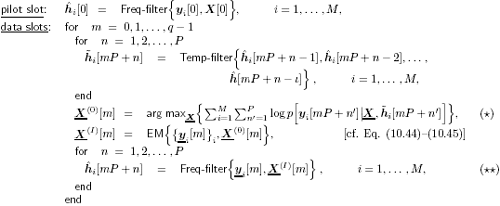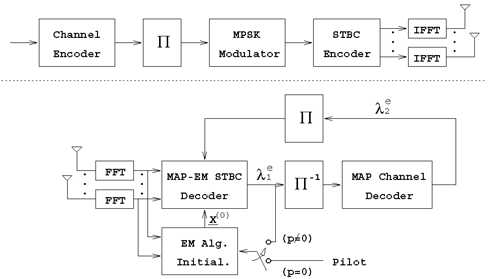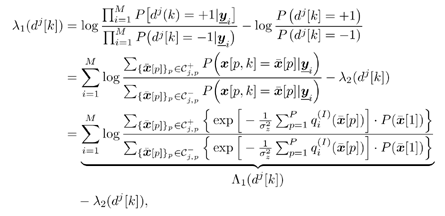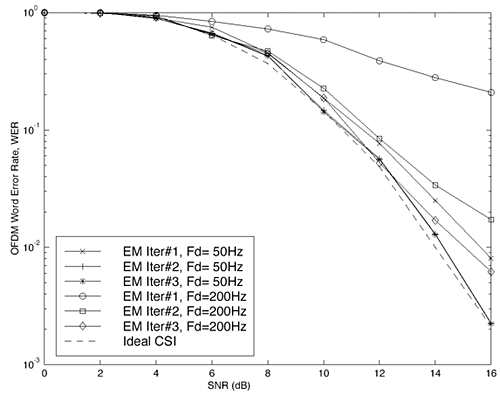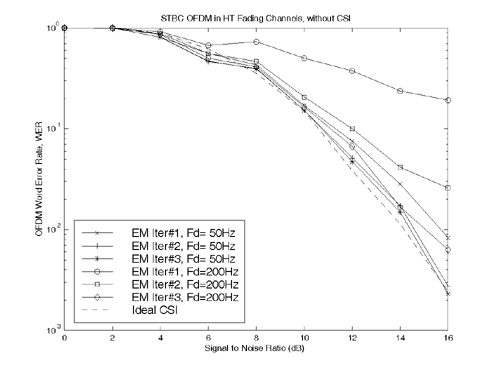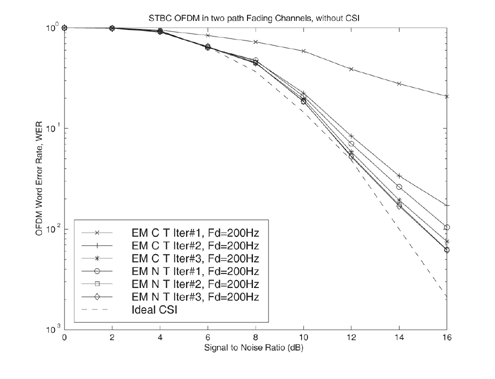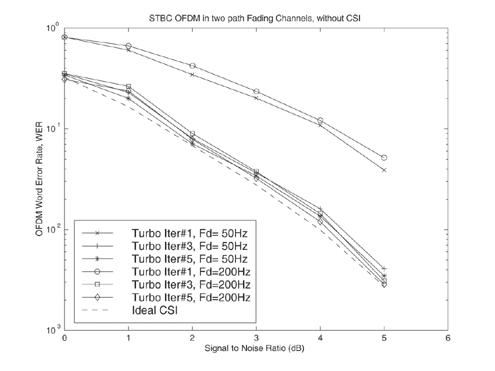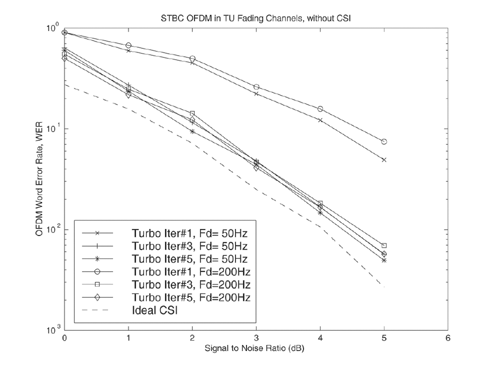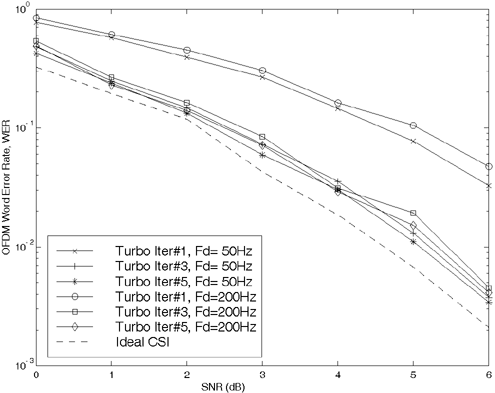10.4 Pilot-Symbol-Aided Turbo Receiver for Space-Time Block-Coded OFDM Systems
10.4 Pilot-Symbol-Aided Turbo Receiver for Space-Time Block-Coded OFDM SystemsIn Section 10.3 we have treated the problem of blind receiver design based on MCMC methods for OFDM systems. In this section we discuss the design of a pilot-symbol-aided receiver for OFDM communication systems operating over frequency-selective fading channels. Here we treat a general scenario where multiple transmit and receive antennas are employed. It is assumed that space-time block coding (STBC) (cf. Sections 5.5.2 and 6.7) is adopted at the transmitter end. The techniques in this section were developed in [292]. 10.4.1 System DescriptionsWe consider an STBC-OFDM system with Q subcarriers, N transmitter antennas, and M receiver antennas, signaling through frequency- and time-selective fading channels. As illustrated in Fig. 10.12, the information bits are first modulated by an MPSK modulator ; then the modulated MPSK symbols are encoded by an STBC encoder. Each STBC code word consists of ( PN ) STBC symbols, which are transmitted from N transmitter antennas and across P consecutive OFDM slots at a particular OFDM subcarrier . The STBC code words at different OFDM subcarriers are independently encoded, therefore, during P OFDM slots, altogether Q STBC code words [or ( QPN ) STBC code symbols] are transmitted. It is assumed that the fading processes remain static during each OFDM word (one time slot), but it varies from one OFDM word to another, and that the fading processes associated with different transmitter “receiver antenna pairs are uncorrelated. Figure 10.12. Transmitter and receiver structure for an STBC-OFDM system. At the receiver, the signals are received from M receiver antennas. After matched filtering and symbol-rate sampling, the discrete Fourier transform (DFT) is then applied to the received discrete-time signals, to obtain Equation 10.34 with where H i [ p ] is the NQ -vector containing the complex channel frequency responses between the i th receiver antenna and all N transmitter antennas at the p th OFDM slot, which is explained below; x j [ p, k ] is the STBC symbol transmitted from the j th transmitter antenna at the k th subcarrier and at the p th OFDM slot; y i [ p ] is the Q -vector of received signals from the i th receiver antenna and at the p th time slot; z i [ p ] is the ambient noise, which is circularly symmetric complex Gaussian with covariance matrix Consider the channel response between the j th transmitter antenna and the i th receiver antenna. Following [396], the time-domain channel impulse response can be modeled as a tapped delay line, similar to (10.2), given by Equation 10.35 where d ( ·) is the Kronecker delta function; Equation 10.36 where Using (10.36), the signal model in (10.34) can be further expressed as Equation 10.37 with As discussed in Section 6.7, an STBC is defined by a P x N code matrix Equation 10.38 The input to this STBC is the data vector x = [ x 1 , x 2 ] T . During the first time slot, the two symbols in the first row [ x 1 , x 2 ] of In an STBC-OFDM system, we apply the STBC encoder above to data symbols transmitted at different subcarriers independently. For example, by using the STBC defined by Simplified System ModelFrom the description above, it is seen that decoding in an STBC-OFDM system involves the received signals over P consecutive OFDM slots. To simplify the problem, we assume that the channel time responses h i [ p ], p = 1, ... , P , remain constant over the duration of one STBC code word (i.e., P consecutive OFDM slots). As will be seen, such an assumption simplifies the receiver design significantly. Using the channel model in (10.37) and considering the coding constraints of the STBC, the received signals over the duration of each STBC code word is obtained as Equation 10.39 with According to the definitions of W in (10.37) and X in (10.39), we have Equation 10.40 where Equation 10.41 where the last equality follows from the constant modulus property of the symbols { x j [ p , k ]} j, p, k , and the orthogonality property of the STBC [475] as well as that of the OFDM modulation. Hence, (10.40) reduces to Equation 10.42 As will be seen in the following sections, (10.42) is the key equation in designing low-complexity iterative receivers for STBC-OFDM systems. 10.4.2 ML Receiver Based on the EM AlgorithmWe next consider ML receiver design for STBC-OFDM systems. With ideal channel state information (CSI), the optimal decoder has been derived in [476]. However, in practice, CSI must be estimated by the receiver. We develop an EM-based ML receiver for STBC-OFDM systems operating in unknown fast-fading channels. As in a typical data communication scenario, communication is carried out in a bursty manner. A data burst is illustrated in Fig. 10.13. It consists of ( Pq + 1) OFDM words, with the first OFDM word ( p = 0) containing known pilot symbols and the remaining ( Pq ) OFDM words spanning the duration of q STBC code words. Figure 10.13. OFDM time slots allocation in data burst transmission. A data burst consists of Pq +1 OFDM words, with the first OFDM word containing known pilot symbols and the remaining Pq words spanning the duration of q STBC code words. EM-Based STBC-OFDM ReceiverWithout CSI, the maximum likelihood detection problem is written as Equation 10.43 where the summation of log probabilities from all M receiver antennas follows from the assumption that the ambient noise processes at different receiver antennas are independent. It is seen in (10.43) that the direct computation of optimal ML decisions involves multidimensional integration over the unknown random vector h i , and hence is of prohibitive complexity. Next, we turn to the EM algorithm to solve (10.43). As discussed in Section 9.3.1, the basic idea of the EM algorithm is to solve problem (10.43) iteratively according to the following two steps: Equation 10.44 Equation 10.45 where X ( k ) contains hard decisions on the data symbols at the k th EM iteration and X ( k ) satisfies the STBC coding constraints. It is known that the likelihood function In the E-step, the expectation is taken with respect to the "hidden" channel response h i conditioned on y i and X ( k ) . It is easily seen that conditioned on y i and X ( k ) , h i has a complex Gaussian distribution. Using (10.39) and (10.42), this distribution can be expressed as Equation 10.46 with Equation 10.47 Equation 10.48 where S z and Equation 10.49 Equation 10.50 where Equation 10.51 with Equation 10.52 It is seen that in the E-step, due to the orthogonality properties of the STBC and the OFDM modulation (10.42), no matrix inversion is involved. Therefore, the computational complexity of the E-step is reduced from Equation 10.53 with where tr( A ) denotes the trace of the matrix A , and [ A ] ( i ', j ') denotes the ( i',j' )th element of the matrix A . Next, based on (10.53), the M-step in (10.45) proceeds as follows: Equation 10.54 It is seen from (10.54) that the M-step can be decoupled into Q independent minimization problems, each of which can be solved by enumerating over all possible x [ p, k ] Initialization of the EM AlgorithmThe performance of the EM algorithm (and hence the overall receiver) is closely related to the quality of the initial value of X (0) [cf. Eq. (10.44)]. The initial estimate of X (0) is computed based on the method proposed in [260, 263] by the following steps. First, a linear estimator is used to estimate the channel with the aid of pilot symbols or decision feedback of the data symbols. Second, the resulting channel estimate is refined by a temporal filter to further exploit the time-domain correlation of the channel. Finally, conditioned on the temporally filtered channel estimate, X (0) is obtained through ML detection. We next elaborate on the linear channel estimator as well as the temporal filtering. Least-Squares Channel Estimator In (10.47), by assuming perfect knowledge of Equation 10.55 with It is seen that in (10.55), unlike a typical least-squares estimator, no matrix inversion is involved here. Hence, its complexity is reduced from Finally, the procedure for initializing the EM algorithm is listed in Table 10.1. Here, the ML detection in (*) takes into account the STBC coding constraints of X . Freq-filter denotes the least-squares estimator, where X [0] represents the pilot symbols and X ( I ) [ m ], m = 0, ..., q “ 1, represent hard decisions of the data symbols X [ m ] which are provided by the EM algorithm after a total of I EM iterations. Temp-filter denotes the temporal filter [260, 263], which is used to further exploit the time-domain correlation of the channel within one OFDM data burst [i.e., ( Pq + 1) OFDM slots]: Equation 10.56 where Equation 10.57 Table 10.1. Procedure for Computing X ( ) for the EM Algorthim
where Temp-filter p computes 10.4.3 Pilot-Symbol-Aided Turbo ReceiverIn practice, in order to impose the coding constraints across the various OFDM subcarriers and further improve receiver performance, an outer channel code (e.g., a convolutional code or turbo code) is usually applied in addition to the STBC. As illustrated in Fig. 10.14, the information bits are encoded by an outer-channel-code encoder and then interleaved. The interleaved code bits are modulated by an MPSK modulator. Finally, the modulated MPSK symbols are encoded by an STBC encoder and transmitted from N transmitter antennas across the P consecutive OFDM slots at a particular OFDM subcarrier. During P OFDM slots, altogether Q STBC code words [or ( QPN ) STBC symbols] are transmitted. Figure 10.14. Transmitter and receiver structure for an STBC-OFDM system with outer channel coding. P denotes the interleaver and P -1 denotes the corresponding deinterleaver. In what follows we discuss a turbo receiver employing the maximum a posteriori probability (MAP)-EM STBC decoding algorithm and the MAP outer-channel-code decoding algorithm for this concatenated STBC-OFDM system, as depicted in Fig. 10.14. It consists of a soft MAP-EM STBC decoder and a soft MAP outer-channel-code decoder. The MAP-EM STBC decoder takes as input the fast Fourier transform (FFT) of the received signals from M receiver antennas, and the interleaved extrinsic log-likelihood ratios of the outer-channel-code bits STBC-OFDM Receiver Based on the MAP-EM AlgorithmWithout CSI, the MAP detection problem can be written as Equation 10.58 The MAP-EM algorithm solves (10.58) iteratively according to the following two steps: Equation 10.59 Equation 10.60 Comparing the MAP-EM algorithm in (10.59) “(10.60) with the maximum likelihood EM algorithm in (10.44) “(10.45), we see that the E-step is exactly the same, but the M-step of the MAP-EM algorithm includes an extra term P ( X ), which represents the a priori probability of X , which is fed back by the outer-channel-code decoder from the previous turbo iteration. Similar to (10.54), the M-step for the MAP-EM can be written as Equation 10.61 where the second equality in (10.61) holds by assuming that the outer-channel-code bits are ideally interleaved and hence x [ p, k ], at different OFDM subcarriers are independent. The last equality in (10.61) follows from the fact that x [ p, k ], p = 2, ... P , are uniquely determined by x [1, k ] according to the STBC coding constraints. Note that when computing the M-step in (10.61), we consider only the coding constraints of the STBC; the coding constraints induced by the outer channel code are exploited by the MAP outer-channel-code decoder and the turbo processing. Within each turbo iteration, the E-step and M-step above are iterated I times. At the end of the I th EM iteration, the extrinsic a posteriori LLRs of the outer-channel-code bits are computed, and then fed to the MAP outer-channel-code decoder. Recall that only the STBC symbols in the first OFDM slot are obtained from the MPSK modulation of outer-channel-code bits; the STBC symbols transmitted during the remaining ( P - 1) OFDM slots are simply permutations and/or transformations of the STBC symbols in the first OFDM slot, as defined in (10.38). At each OFDM subcarrier, N transmitter antennas transmit N STC symbols, which correspond to ( N log 2 W ) outer-channel-code bits. Based on (10.61), after I EM iterations, the extrinsic a posteriori LLR of the j th ( j = 1, ... , N log 2 W ) outer-channel-code bit at the k th subcarrier d j ( k ) is computed at the output of the MAP-EM STBC decoder as follows: Equation 10.62 where The MAP-EM algorithm needs to be initialized at each turbo iteration. Except for the first turbo iteration, Simulation Examples In this section we provide computer simulation results to illustrate the performance of the proposed iterative receivers for STBC-OFDM systems, with or without outer channel coding. The receiver performance is simulated in three typical channel models with different delay profiles: the two-ray, typical urban (TU), and hilly terrain (HT) model with 50-Hz and 200-Hz Doppler frequencies [263]. In the following simulations the available bandwidth is 800 kHz and is divided into 128 subcarriers. These correspond to a subcarrier symbol rate of 5 kHz and OFDM word duration of 160 m s. In each OFDM word, a cyclic prefix interval of 40 m s is added to combat the effect of intersymbol interference, hence the duration of one OFDM word T = 200 m s. For all simulations, two transmitter antennas and two receiver antennas are used; and the Performance of the EM-Based ML Receiver In an STBC-OFDM system without outer channel coding, 512 information bits are transmitted from 128 subcarriers during two ( P = 2) OFDM slots; therefore, the information rate is 2x160/200 = 1.6 bits/s per hertz, with 160/200 being the factor induced by the cyclic prefix interval. In Figs. 10.15 “10.17, when ideal CSI is assumed to be available at the receiver side, the ML performance is shown in dashed lines, denoted by Ideal CSI . (Note that the ML performance difference between the 50-Hz and the 200-Hz Doppler fading channels is unnoticeable; hence, we only present the ML performance when f d = 50 Hz.) Without the CSI, the EM-based ML receiver is employed. The performance after each EM iteration is demonstrated in curves denoted by EM Iter#1 , EM Iter#2 , and EM Iter#3 . From the figures it is seen that the receiver performance is significantly improved through EM iteration. Furthermore, although the receiver is designed under the assumption that the fading channels remain static over one STBC code word (whereas the actual channels vary within one STBC code word), it can perform close to the ML performance with ideal CSI after two or three EM iterations for all three types of channels with a Doppler frequency as high as 200 Hz. Figure 10.15. Word-error rate of a multiple-antenna ( N = 2, M = 2) STBC-OFDM system in two-ray fading channels with Doppler frequencies f d = 50 and 200 Hz. Figure 10.16. Word-error rate of a multiple-antenna ( N = 2, M = 2) STBC-OFDM system in typical urban (TU) fading channels with Doppler frequencies f d = 50 and 200 Hz. Figure 10.17. Word-error rate of a multiple-antenna ( N = 2, M = 2) STBC-OFDM system in hilly terrain (HT) fading channels with Doppler frequencies f d = 50 and 200 Hz. In Fig. 10.18, the performance of an EM-based ML receiver employing the causal temporal filtering scheme (denoted by C-T ) is compared with that employing the noncausal temporal filtering scheme (denoted by N-T ) in two-ray fading channels. It is seen that applying a second-round noncausal temporal filtering in addition to the first-round causal temporal filtering [263] does not bring much performance improvement to the EM-based ML receiver considered here, which is also true for the TU and HT fading channels. Because in the proposed EM-based ML receiver the performance improvement is achieved mainly by the EM iterations, we conclude that only causal temporal filtering is needed for initializing the EM algorithm. Figure 10.18. Word-error rate of a multiple-antenna ( N = 2, M = 2) STBC-OFDM system in two-ray fading channels with Doppler frequency f d = 200 Hz. Comparison of different temporal filtering schemes in initializing the EM algorithm. Performance of the MAP-EM-Based Turbo Receiver A four-state rate- ½ convolutional code with generator (5,7) in octal notation is adopted as the outer channel code, as depicted in Fig. 10.14. The overall information rate for this system is 0.8 bits/s per hertz. Figures 10.19 “10.21 show the performance of the turbo receiver employing the MAP-EM algorithm for this concatenated STBC-OFDM system. The performance of the turbo receiver after the first, third, and fifth turbo iteration is demonstrated, respectively, in curves denoted by Turbo lter#1, Turbo lter#3 , and Turbo lter#5 . During each turbo iteration, three EM iterations are carried out in the MAP-EM STBC decoder. Ideal CSI denotes the approximated ML lower bound, which is obtained by performing the MAP STBC decoder with ideal CSI and iterating a sufficient number of turbo iterations (three to four iterations are shown to be enough for the systems simulated here) between the MAP STBC decoder and the MAP convolutional decoder. From the simulation results, it is seen that by employing outer channel coding, the receiver performance is significantly improved (at the expense of lowering spectral efficiency). Moreover, without CSI, after three to five turbo iterations, the turbo receiver performs close to the approximated ML lower bound in all three types of channels with a Doppler frequency as high as 200 Hz. Figure 10.19. Word-error rate of a multiple-antenna ( N = 2, M = 2) STBC-OFDM system with outer convolutional coding in two-ray fading channels with Doppler frequencies f d = 50 and 200 Hz. Figure 10.20. Word-error rate of a multiple-antenna ( N = 2, M = 2) STBC-OFDM system with outer convolutional coding in typical urban (TU) fading channels with Doppler frequencies fd = 50 and 200 Hz. Figure 10.21. Word-error rate of a multiple-antenna ( N = 2, M = 2) STBC-OFDM system with outer convolutional coding in hilly terrain (HT) fading channels with Doppler frequencies f d = 50 and 200 Hz. |
EAN: 2147483647
Pages: 91





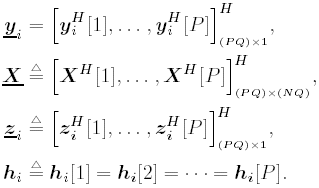










 W
W 





